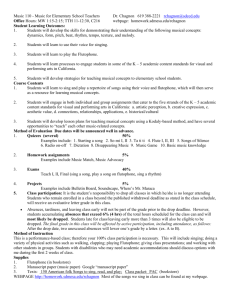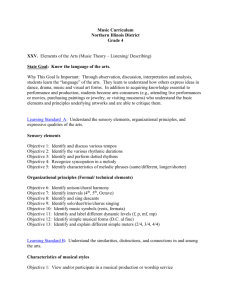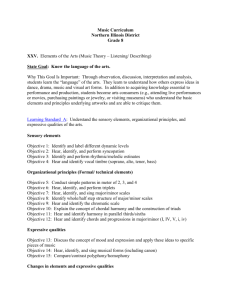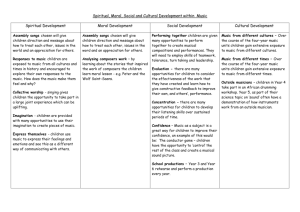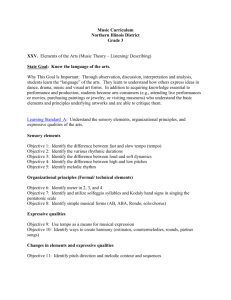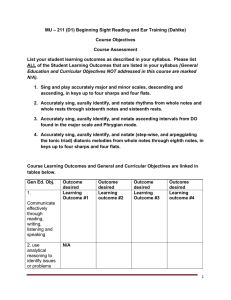Music 5th Grade - Northern Illinois District
advertisement
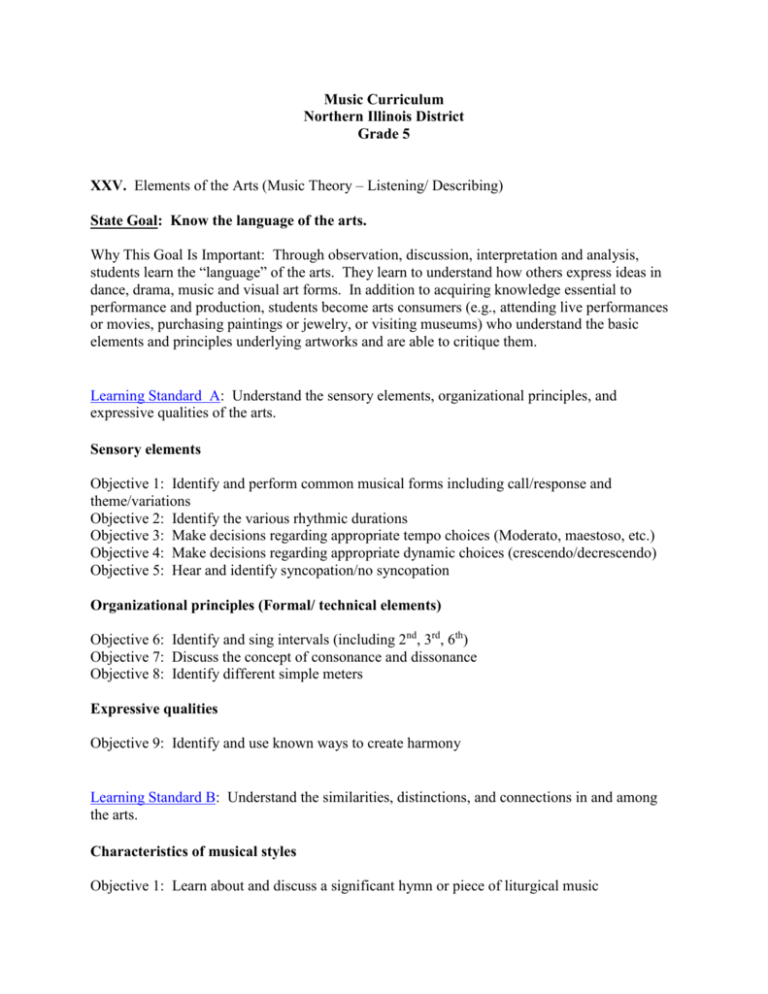
Music Curriculum Northern Illinois District Grade 5 XXV. Elements of the Arts (Music Theory – Listening/ Describing) State Goal: Know the language of the arts. Why This Goal Is Important: Through observation, discussion, interpretation and analysis, students learn the “language” of the arts. They learn to understand how others express ideas in dance, drama, music and visual art forms. In addition to acquiring knowledge essential to performance and production, students become arts consumers (e.g., attending live performances or movies, purchasing paintings or jewelry, or visiting museums) who understand the basic elements and principles underlying artworks and are able to critique them. Learning Standard A: Understand the sensory elements, organizational principles, and expressive qualities of the arts. Sensory elements Objective 1: Identify and perform common musical forms including call/response and theme/variations Objective 2: Identify the various rhythmic durations Objective 3: Make decisions regarding appropriate tempo choices (Moderato, maestoso, etc.) Objective 4: Make decisions regarding appropriate dynamic choices (crescendo/decrescendo) Objective 5: Hear and identify syncopation/no syncopation Organizational principles (Formal/ technical elements) Objective 6: Identify and sing intervals (including 2nd, 3rd, 6th) Objective 7: Discuss the concept of consonance and dissonance Objective 8: Identify different simple meters Expressive qualities Objective 9: Identify and use known ways to create harmony Learning Standard B: Understand the similarities, distinctions, and connections in and among the arts. Characteristics of musical styles Objective 1: Learn about and discuss a significant hymn or piece of liturgical music Objective 2: View and/or participate in a sacred/secular musical production Similarities, contrasts, and relationships between music and the other fine arts Objective 3: Learn about and discuss a significant musical theater piece 2 XXVI. Performance of the Arts (Applied Music – Creating/ Reading/ Performing) State Goal: Through creating and performing, understand how works of art are produced. Why This Goal Is Important: Students acquire skills to produce and perform dance, drama, music and visual art. They learn to use media, tools and technologies. They learn to shape ideas and emotions into sounds, images and actions. As students create and perform their own artworks and review the works of others, they become more imaginative, strengthen their problem-solving skills and learn to respond to the creativity of others. Creating and performing are at the core of the fine arts. Students also learn about the role of the artist (e.g., dancer, painter, actor, director, scriptwriter, musician). Learning Standard A: Understand processes, traditional tools, and modern technologies used in the arts. Processes used to create solo, ensemble, and choral music Objective 1: Explain at least one process of composition Objective 2: Describe the interaction between performers and conductors in a performance Instrumental and electronic music Objective 3: Review how sound is produced (acoustic vs. electronic music) Translation of written symbols of music Objective 4: Identify 2/4, 3/4, 4/4, 6/8 time signature Objective 5: Identify and label notes in bass clef Use of musical notation Objective 6: Perform songs reading standard music notation Objective 7: Use standard notation to record/write musical ideas Objective 8: Identify and perform rhythms and melodies using standard notation (whole, half, dotted half, quarter, paired eighth, single eighth notes, and their corresponding rests) Objective 9: Identify various expressive markings of standard notation (e.g. dynamics, tempos, articulations) Learning Standard B: Apply skills and knowledge necessary to create and perform in one or more of the arts. Musical performance techniques 3 Objective 1: Sing or play music accurately, reading standard music notation; on pitch; in rhythm; maintaining a steady tempo; using appropriate volume; demonstrating breath control; demonstrating proper singing and/or playing technique; and demonstrating proper articulations/diction Objective 2: Sing from “All God’s People Sing” hymnal Objective 3: Sing songs appropriate to the seasons of the Church year for performance at worship service Vocal or instrumental writing and improvisational techniques Objective 4: Improvise rhythmic and melodic variations of a given song Objective 5: Create short vocal and/or instrumental songs within specific guidelines 4 XXVII. The History and Application of the Arts (Music Appreciation) State Goal: Understand the role of the arts in civilizations, past and present. Why This Goal Is Important: The arts are a record of civilizations, past and present. Artists are influenced by—and influence—the times and places in which they live and work. As students learn through the arts about people and civilizations, they learn about others and themselves. Also, students learn about careers related to this goal (e.g., animator, curator, art historian, sound technician). Learning Standard A: Analyze how the arts function in history, society, and everyday life. Roles of artists and audiences Objective 1: Demonstrate appropriate audience/worshipper behavior and evaluate the behavior of self and others Objective 2: Describe how audience/worshipper behavior changes a performance or service Influence of music on societies, civilizations, cultures, and the church Objective 3: Compare and contrast how music functions in similar types of ceremonies (e.g., parades – Thanksgiving Day Parade and Mardi Gras; Opening Ceremony – Super Bowl and World Series) Objective 4: Give examples in which music is used to persuade, promote ideas, and create moods Objective 5: Explain that our hymnals contain psalms, hymns, and liturgical music that connect us with people from many cultures and across many centuries (Psalm 117) How music can express universal and specific Christian themes Objective 6: Discuss and demonstrate proper worship behavior Objective 7: Sing songs appropriate to the seasons of the church year Objective 8: Identify and discuss different musical ensembles and how they are used in church How God’s Word can be communicated and remembered effectively when joined together with music Objective 9: Give examples of how music is utilized in daily Christian life Objective 10: Participate in Lutheran worship experiences where God is praised with various instruments and voices Objective 11: Listen to and/or learn songs based on various scriptures and Christian concepts Learning Standard B: Understand how the arts shape and reflect history, society, and everyday life. 5 Changes in music through the ages: their classification by artistic periods, and their relationships to historical periods and cultures Objective 1: Discuss how a specific musical work and artist influenced society in a given time period Objective 2: Sing hymns and songs from various times in our church’s history Objective 3: Listen and discuss how music of different time periods, from our own cultures as well as other cultures, relates to our society now Objective 4: Discuss the historical, social, and theological roots of hymns and liturgy used in the Lutheran Church – Missouri Synod Objective 5: List artists who have made significant contributions and describe their ideas 6
